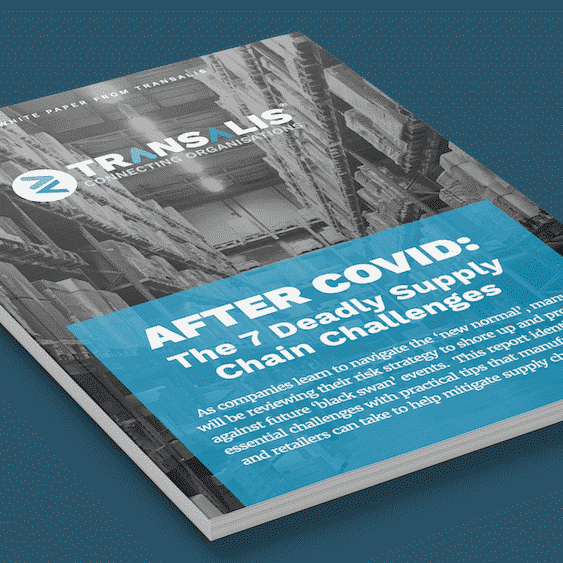Discover how EDI can strengthen embattled retail supply chains in preparation for the next normal
The pandemic is already being referred to as ‘the great accelerator’ by retail analysts, and few places are feeling its impact more acutely than embattled mid-size retail supply chains.
Covid-19 has acted as a catalyst. It has sped up the need for retail transformation and propelling the sector not just to the ‘new normal’, but on to what comes next, post pandemic. The effects of the overnight seismic shifts in consumer behaviour and far-ranging health restrictions have rippled through retailers’ supply chains, putting unimagined stress on global networks.
This has been a painful process for retailers as their supply chain weaknesses have been laid bare. But it is also a prime opportunity to learn and emerge from lockdown better equipped to deal with future shocks.
Creating retail supply-chain flexibility with EDI
The pandemic has been a tale of two halves for retail. An explosion in demand for non-discretionary goods and lockdown staples (such as electricals, home and leisure goods) has led to empty warehouse racking for some retailers. Meanwhile, many discretionary retail segments, especially fashion and footwear, have seen demand evaporate overnight.
The coping mechanism for both of these challenges has been increased agility. Retailers capable of flexing their supply chains at speed, onboarding new suppliers and redeploying resources where necessary, have weathered the storm best.
For many retailers, EDI solutions have been a vital tool in this process as they dramatically speed up the onboarding of new suppliers, while significantly reducing the amount of admin required. Retailers with cloud EDI systems have also had rapid access to a large pool of international suppliers – all using the same document protocols and plugged in to the same electronic networks. This has made business decisions faster, easier and much more effective during the crisis.
Discover more about retail supply chain agility by reading our latest white paper.
The benefits of real-time visibility with cloud-based EDI
EDI-powered retailers who suffered a dramatic drop in demand were also been able to manage their stock levels faster and more effectively. Cloud-based EDI has given these retailers an accurate real-time view of warehouse inventory and enabled them to turn off the supply tap selectively when necessary.
The beauty of EDI paper-to-digital solutions in both of these scenarios is that it can seamlessly integrate with a retailer’s existing enterprise resource planning (ERP) system and can be delivered quickly and effectively by an external supplier. This removes the need for in-house development, reduces risk and significantly reduces cost. Read Transalis’ latest white paper for more information about seamless EDI integration.
Supply chain resilience doesn’t begin and end with matching product orders to shopper demand, as retailers of all stripes are aware. The pandemic has shown that rapid supply chain recalibration has an effect right across retail operations, including purchasing, planning and inventory management.
Recalibrating retail supply chains at speed
For example, during lockdown retailers of non-discretionary goods had to re-align their purchasing plans to focus on high-demand products and then move stock to stores and delivery hubs where it was needed most.
The shift in consumer behaviour has often been so dramatic that retailers of all shapes and sizes have been forced to rip up their existing plans and strategies and start from scratch.
In such an unpredictable environment, retailers using cloud-based EDI solutions have benefitted from knowing in real time the status of invoices, orders and shipments, as well as knowing exactly what stock they hold and where it is. This is true even if your supply chain contains hundreds of trading partners, each with their own data formats and processes.
What’s more, EDI protect precious supplier relationships thanks to a much faster invoice-to-cash cycle made possible by EDI. Achieving frictionless digital invoice payments is a great advantage. An automatic EDI invoice payment application instantly takes a huge amount of uncertainty out of the situation for both suppliers and their retailer buyers.
Cloud-based EDI is no longer a ‘tier one’ retailer solution
EDI paper-to-digital solutions aren’t just for the retail giants. Gone are the days when top-flight retailers were the only ones who could afford the benefits of digital document exchange. Leading EDI suppliers no longer base their fees on VAN charges – an approach that can lead to uncertainty and spiraling costs.
Next-generation cloud-based EDI means everyone can benefit. With the right supplier, retailers can leapfrog their tier-one competitors and enjoy the full power of cloud-based EDI.
With enhanced EDI digitisation, all parts of the supply network can now store, record and secure essential documentation in perpetuity, giving you a single view and complete peace of mind about trust and traceability.
Is your EDI supplier delivering value for money?
There have been great developments in EDI technology in recent years and it’s critical to your company’s profitability that you’re enjoying as many of these benefits as possible. Now is the time to have a frank discussion with your supplier to ensure you’re getting a market-leading cloud-based solution as well as maximum bang for your buck.
For example, are you still paying data transmission costs that your supplier is doing nothing, or very little, to justify? Ask your EDI supplier if data transmission is included as part of a fixed-fee service so you can be certain of where you stand on cost at all times. Demand a clear pricing model reflecting exactly the level of help you need and with no hidden extras or upfront fees.
Discover more ways to strengthen your retail supply chains
To discover more insights designed to strengthen your retail supply chains, download the latest Transalis white paper now: After Covid: how to mitigate the risk of supply chain disruption.
FREE WHITEPAPER
After Covid
7 essential challenges with practical tips that manufacturers and retailers can take to help mitigate supply chain risks.

Related Posts
February 20, 2025
The ultimate guide to Electronic Data Interchange (EDI)
Understand how EDI works and get…




